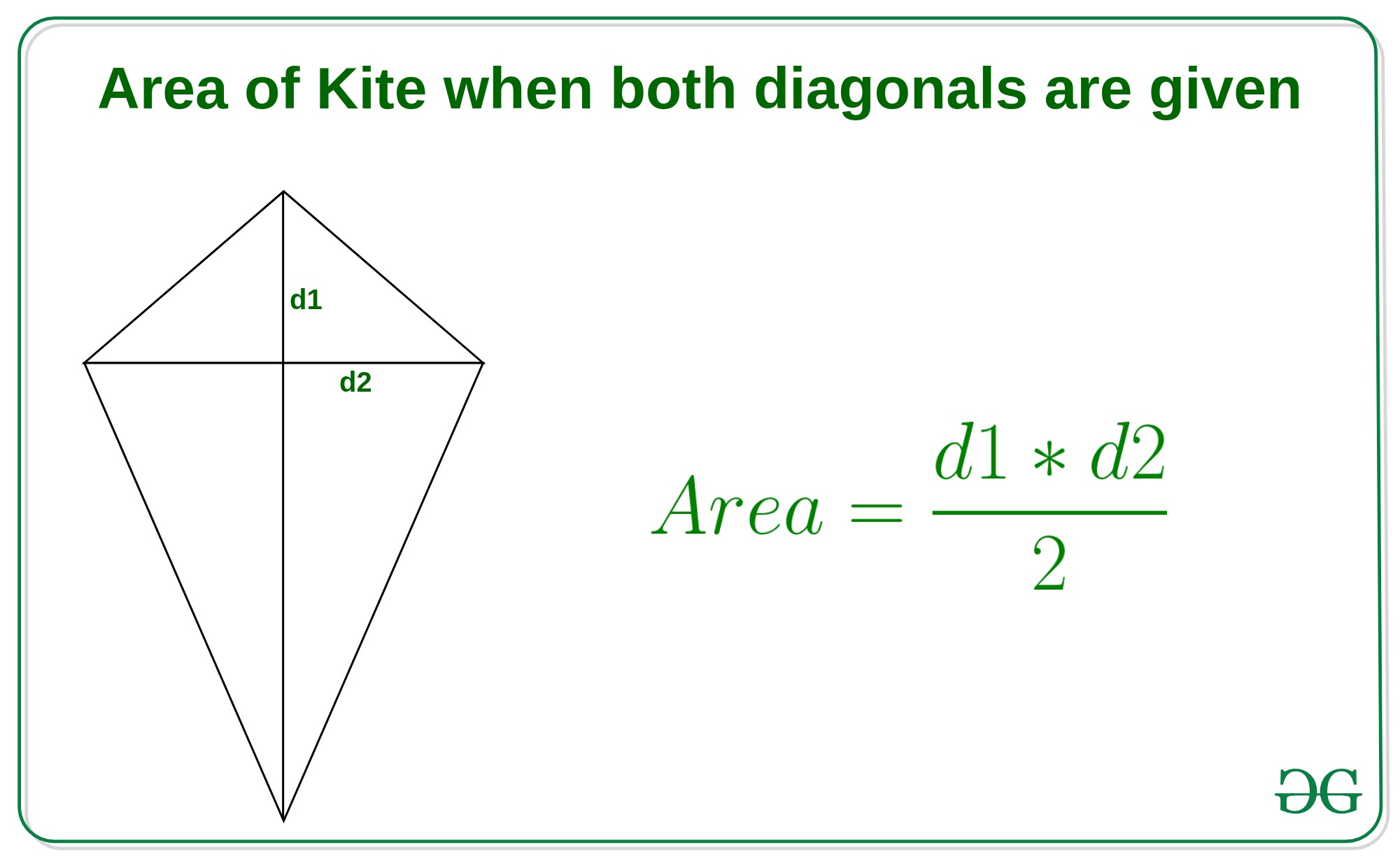Kite es algo así como rombo pero en Kite, los lados adyacentes son iguales y las diagonales generalmente no son iguales.
Método 1: cuando se dan ambas diagonales
Si se dan las diagonales d1 y d2 de la cometa, entonces el área de una cometa es la mitad del producto de ambas diagonales, es decir
Ejemplo:
Input: d1 = 4, d2 = 6 Output: Area of Kite = 12 Input: d1 = 5, d2 = 7 Output: Area of Kite = 17.5
Enfoque: en este método simplemente usamos la fórmula anterior.
A continuación se muestra la implementación del enfoque anterior:
C++
// C++ implementation of the approach
#include <bits/stdc++.h>
using namespace std;
// Function to return the area of kite
float areaOfKite(int d1, int d2)
{
// use above formula
float area = (d1 * d2) / 2;
return area;
}
// Driver code
int main()
{
int d1 = 4, d2 = 6;
cout << "Area of Kite = "
<< areaOfKite(d1, d2);
return 0;
}
Java
// Java implementation of the approach
class GFG
{
// Function to return the area of kite
static float areaOfKite(int d1, int d2)
{
// Use above formula
float area = (d1 * d2) / 2;
return area;
}
// Driver code
public static void main(String[] args)
{
int d1 = 4, d2 = 6;
System.out.println("Area of Kite = "
+ areaOfKite(d1, d2));
}
}
// This code is contributed by Rajput-Ji
Python3
# Python implementation of the approach
# Function to return the area of kite
def areaOfKite(d1, d2):
# use above formula
area = (d1 * d2) / 2;
return area;
# Driver code
d1 = 4;
d2 = 6;
print("Area of Kite = ",
areaOfKite(d1, d2));
# This code is contributed by Rajput-Ji
C#
// C# implementation of the approach
using System;
class GFG
{
// Function to return the area of kite
static float areaOfKite(int d1, int d2)
{
// Use above formula
float area = (d1 * d2) / 2;
return area;
}
// Driver code
public static void Main()
{
int d1 = 4, d2 = 6;
Console.WriteLine("Area of Kite = "
+ areaOfKite(d1, d2));
}
}
// This code is contributed by anuj_67..
Javascript
<script>
// Javascript implementation of the approach
// Function to return the area of kite
function areaOfKite(d1, d2)
{
// use above formula
var area = (d1 * d2) / 2;
return area;
}
// Driver code
var d1 = 4, d2 = 6;
document.write("Area of Kite = "
+ areaOfKite(d1, d2));
</script>
Area of Kite = 12
Complejidad de tiempo: O(1)
Espacio Auxiliar: O(1)
Método 2: Cuando se dan los lados a, b y el ángulo:

Cuando se dan los lados desiguales de la cometa a y b y el ángulo Θ incluido entre ellos, entonces
Ejemplo:
Input: a = 4, b = 7, θ = 78 Output: Area of Kite = 27.3881 Input: a = 6, b = 9, θ = 83 Output: Area of Kite = 53.5975
Enfoque: en este método simplemente usamos la fórmula anterior.
A continuación se muestra la implementación del enfoque anterior:
C++
// C++ implementation of the approach
#include <bits/stdc++.h>
#define PI 3.14159 / 180
using namespace std;
// Function to return the area of the kite
float areaOfKite(int a, int b, double angle)
{
// convert angle degree to radians
angle = angle * PI;
// use above formula
double area = a * b * sin(angle);
return area;
}
// Driver code
int main()
{
int a = 4, b = 7, angle = 78;
cout << "Area of Kite = "
<< areaOfKite(a, b, angle);
return 0;
}
Java
// Java implementation of the approach
import java.io.*;
class GFG
{
static double PI = (3.14159 / 180);
// Function to return the area of the kite
static float areaOfKite(int a, int b, double angle)
{
// convert angle degree to radians
angle = angle * PI;
// use above formula
double area = a * b * Math.sin(angle);
return (float)area;
}
// Driver code
public static void main (String[] args)
{
int a = 4, b = 7, angle = 78;
System.out.println ("Area of Kite = " + areaOfKite(a, b, angle));
}
}
// This code is contributed by jit_t.
Python3
# Python implementation of the approach
import math
PI = 3.14159 / 180;
# Function to return the area of the kite
def areaOfKite(a, b, angle):
# convert angle degree to radians
angle = angle * PI;
# use above formula
area = a * b * math.sin(angle);
return area;
# Driver code
a = 4; b = 7; angle = 78;
print("Area of Kite = ",
areaOfKite(a, b, angle));
# This code contributed by PrinciRaj1992
C#
// C# implementation of the approach
using System;
class GFG
{
static double PI = (3.14159 / 180);
// Function to return the area of the kite
static float areaOfKite(int a, int b, double angle)
{
// convert angle degree to radians
angle = angle * PI;
// use above formula
double area = a * b * Math.Sin(angle);
return (float)area;
}
// Driver code
static public void Main ()
{
int a = 4, b = 7, angle = 78;
Console.WriteLine("Area of Kite = " + areaOfKite(a, b, angle));
}
}
// This code is contributed by ajit
Javascript
<script>
// Javascript implementation of the approach
var PI = 3.14159 / 180
// Function to return the area of the kite
function areaOfKite(a, b, angle)
{
// convert angle degree to radians
angle = angle * PI;
// use above formula
var area = a * b * Math.sin(angle);
return area.toFixed(4);
}
// Driver code
var a = 4, b = 7, angle = 78;
document.write( "Area of Kite = "
+ areaOfKite(a, b, angle));
// This code is contributed by rutvik_56.
</script>
Area of Kite = 27.3881
Complejidad de tiempo: O(1)
Espacio Auxiliar: O(1)